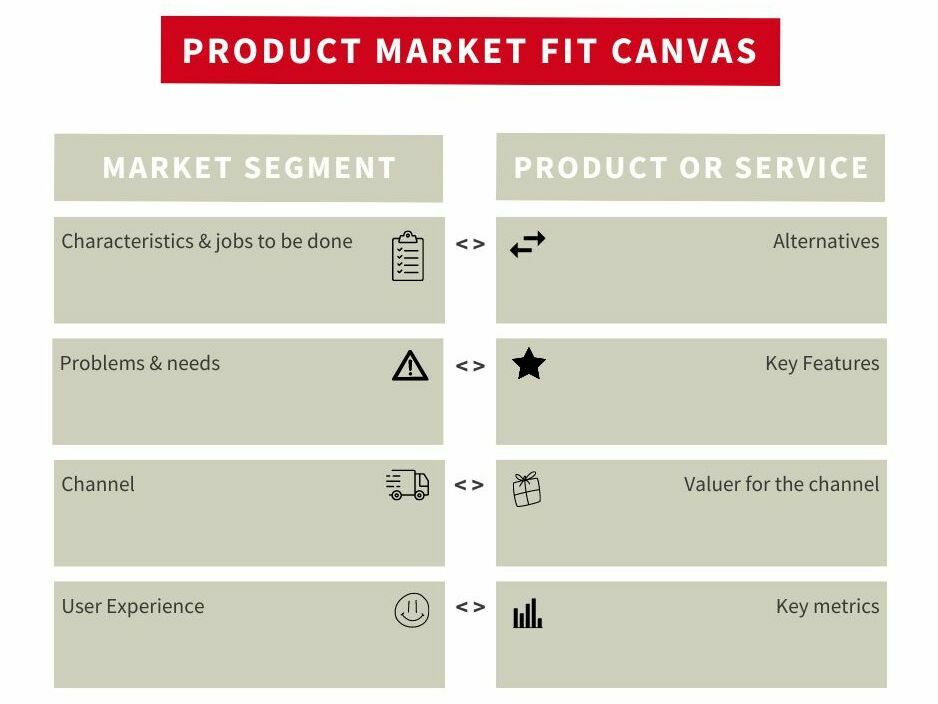How start-ups achieve product market fit
StartupsEstablish your start-up in the market

Your idea is groundbreaking, you are convinced of your product? Unfortunately, that's not all it takes for success. Do you know what your customers need? Do you keep an eye on the competition? And what has actually happened to your business model in the drawer? Here you will find information about market fit so that your idea can survive in the market.
We introduced you to the study by CB Insights, in which 101 failed start-ups were asked about the reasons for their failure. As a result, CB Insights compiled a list of the 20 most frequently cited answers. Six of the 20 reasons can be assigned to the topic of "product market fit". Therefore, we take a closer look at the stumbling blocks and recommendations for action in this area.
Definition of Product Market Fit
According to Business Insider Germany, the "product market fit" shows how well the assumptions and decisions of founders around the product are adapted to the target market. To be successful, the product should target existing customer needs. Only when it becomes clear that the product serves the actual existing demand on the market should it be scaled up.
Does one's own product fit the target market?
When start-ups develop new, innovative products, it is difficult to find out whether they appeal to the desired customers. One tool that helps to find out whether your product actually fits the target group is the Product Market Fit Canvas. This is a method that evaluates a new product holistically. For this purpose, a table with two columns is created. The left side shows the market, i.e. the customers, and the right side shows the product. On the customer side, the focus is on who the target group is, what they want and what pain points they have. How can the customers be reached and how is the value proposition realised. On the other side, the start-ups should analyse which solutions the target group already uses to minimise these pain points, which features the new product must have to solve the problems and how big the sales value is. In addition, the most important key figures are selected and it is seen whether the metrics confirm the product market fit.

Analysing demand
The most commonly cited answer to the question of what led to the failure of the start-up is the lack of demand. This can have various reasons:
In the beginning, there is usually the idea to solve a certain problem in a new way. The product you offer is met with great enthusiasm by the three Fs (Friends, Family and Fools)? Good start, but is that your target group? It is important to let potential customers test the first use case. This means that the target group assumption is only confirmed when a real interaction, or better still a sale, has taken place with the real target group. You can then use the feedback to improve your product and make it more valuable and attractive for the target group.
What do you need to keep in mind when developing a product strategy or diving deeper into product development? We have summarised five tips on how you can focus on your product development. In a nutshell, having a product strategy is better than not having one. And it should be derived from the business strategy. It is also important to focus on the customer. Because another problem that has contributed to the failure of start-ups is that the customers have been ignored or the start-ups think that they know exactly what the clientele wants and needs. How can this be avoided?
Take the customer's perspective
In order for a start-up to know whether the product or service will meet with enthusiasm from potential customers, it should be tested beforehand. One method to achieve this is called customer development. Here, the start-up gives the product to the users for testing. The feedback received should be used to improve the product and thus launch it more successfully. There are four phases: Customer identification, customer validation, customer development and company development. This method is also suitable for products that have already been launched but have not yet been able to establish themselves on the market.
However, even if the start-up has thoroughly engaged with its customers, there are other risks, such as competition with other companies and their products. Market changes need to be monitored not only before the start-up, but also in the years after the product launch. Who offers a similar product or service? Who addresses the same target group? In case of changes, product and/or marketing strategies should be adapted. After all, it is the customer who ultimately decides which products or services they choose to solve their "problem".
Plan and implement the business model
In the value proposition canvas, the start-up develops an in-depth analysis of the customer group and considers the benefits for the target group. What problems, wishes or needs do they have? How does the product or service solve exactly these points? By answering these questions, you not only optimise the business model, but at the same time sharpen your view of the customer side and avoid the above-mentioned problem of the missing customer perspective.
Then the Business Model Canvas is a suitable method. The canvas consists of two sides: the supply side and the implementation side. It helps to get a good overview of the key partners, activities, resources, value propositions, customer relationships and segments, distribution channels, cost structure and revenue sources. A template as well as an explanation can be found here at the Starthaus.
Once the business model is created, it should be tested before implementation. Whether through market tests, advertisements or surveys: It is important to clearly define in advance what exactly should be tested and what the desired result would be. You can then compare this with the real result and plan and implement appropriate adjustments.
Pivot
In the start-up context, the word "pivot" refers to the realignment of (product) strategy. Two reasons given in the above-mentioned survey for the failure of start-ups are, on the one hand, "the pivot went wrong" and, on the other, "the failure to pivot". A startup usually undertakes a pivot when the product has not been accepted by the market. If it is realised that customers are not buying the product for a certain reason, the product or the sales strategy has to be rethought completely. Maybe your product or service offers too much at once and you should focus only on one feature that convinces your target group. After the necessary adjustment, a new attempt to conquer the market can be started.
Advice, workshops and support programmes in Bremen and Bremerhaven
Do you have an eye on your market fit? Is there a problem with product development, the customer perspective or your business model? Are you planning a pivot? Then come and see us at Starthaus Bremen & Bremerhaven and we will give you the necessary push to convince the market of you and your product.
Depending on the initial situation, we have various programmes, such as the Open Innovation Cycle, mentoring or the space incubator ESA BIC Northern Germany. In addition, we can support you in prototyping with the Startup Funding Bremen "BRE-Up".
As an ad-hoc solution and to get started, we recommend a one-to-one consultation with our colleagues who specifically look after startups, plan and accompany the programmes and plan suitable workshops.
Do you want to set up your start-up securely? Or do you have construction sites where we can support you? Then send us an email at info@starthaus-bremen.de or call us at +49 (0)421 9600 372 if you have any questions about your start-up (idea). We have the answers.
Success Stories
Start-ups in Bremen: Now even more visible
There is a lot going on in Bremen - together with the local start-up network Starthaus Bremen and Bremerhaven created the interactive Start-up Map. The map shows the entire startup ecosystem, including interesting companies, universities, supporters and programmes.
Discover the Start-up Map BremenHow start-ups set themselves up for financial security
Financial problems have brought some start-ups to an early end. No wonder, given the abundance of issues that start-up founders have to deal with. After all, a good idea is not enough for success. The topic of finances is a constant companion along the way and can pose major challenges. We have summarised some information and tips for you.
Read the tipsFocus on your product development
Even the best product is no use: If customers don't understand it, find it appealing or can't use it, your start-up is doomed to failure. Good news: You can work on your product strategy and development. We'll show you how it works.
Read the tipps